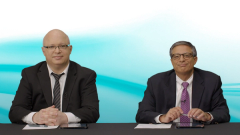
Managing AEs in Multiple Myeloma: Dosing and Prophylactic Strategies
Key opinion leaders share their insight on managing adverse events in myeloma treatment, including dose adjustments and prophylactic strategies to improve outcomes and patient quality of life.
Episodes in this series

Transcript:
Sagar Lonial, MD, FACP: What’s your…threshold for changing the frequency or a dose hold? What do you need to hear to make that decision from a patient?
Luciano Costa, MD: I have to say, I have been a little bit more on the skeptical side that the dose holds would be effective and worth it…with talquetamab, but I think a lot of those symptoms tend to get better over time, particularly the dysgeusia. I wonder sometimes when we dose reduce and it gets better, was it going to get better anyway?
On the opposite [side], I think [given] how those drugs work, they all should be amenable to dose reduction. So I’m OK with dose reduction. We do as [it] aggressive[ly] as we can when patients are on a trial, and I think now talquetamab is being explored even as a monthly dosing. But I’m not necessarily guided by the toxicity.
Sagar Lonial, MD, FACP: How do you all approach that?…It’s an unusual toxicity for us, so I think giving some guidance to our audience on how you manage this would be helpful.
Cesar Rodriguez, MD: And we’re flying by the seat of our pants here, because we don’t have any data to say this is a therapy that’s going to help reduce the dysgeusia in these patients or this is what’s causing the alteration in the taste. We have 2 strategies at [Mount] Sinai [Hospital]: We’re favoring every-other-week dosing and the weekly dosing for the talquetamab, [because] the FDA approval gives us both options.
Sagar Lonial, MD, FACP: But every-other-week dosing is double the dose.
Cesar Rodriguez, MD: It’s double the dose. Correct.
Sagar Lonial, MD, FACP: So you’re basically getting the same dose exposure, and the peak rate is higher.
Cesar Rodriguez, MD: We don’t know if the [adverse] effects are caused by the intensity of the dose or the frequency of the dosage, so we’re favoring the every other week. And then if a patient has achieved a good response, then we’re spacing it out to monthly. If the patient is having symptoms beforehand, and these symptoms are really impacting their quality of life, where we’re starting to see a drop in their weight, then we are either reducing the dose or spacing it out as well.
Sagar Lonial, MD, FACP: And skin. So let’s briefly touch on skin and nails because that is easily apparent to everybody. What can people expect with an average patient who’s getting talquetamab?
Donna Catamero, NP: We usually see these skin changes within the first few doses of the first few weeks of treatment. And to me, they’re self-limiting. We can manage them well with heavy moisturizers, ammonium lactate lotion.
And with the nails, yes, they’re going to have that ridging, weak brittle nails for the duration of therapy. We recommend nail hardener, but it’s mostly aesthetic. These are not painful toxicities.… It’s setting expectations for the patients, how we’re going to manage skin toxicities. I think we’ve done a good job of making it very self-limiting, and they resolve and we can move on. These aren’t anything that we’re discontinuing patients for. We manage it in continued treatment without incidence.
Cesar Rodriguez, MD: And the nail tends to be the biggest problem. We do see patients have also some skin changes in the palms and the feet, but it’s not as bad or as frequent as the nail changes. And very few patients actually describe changes in sensitivity in the bed of the nails. But like Donna was saying, the use of these creams or sometimes even steroid application whenever they do have the…does help with the symptoms. It hasn’t been a cause to discontinue therapy.
And after time, once we space out the dosing, we do start to see the nail regrow. The nail changes although we haven’t paid much attention, but I don’t know if you’ve noticed it when we do transplants and we give the melphalan and we see that change. This is just more persistent and continuous.
Sagar Lonial, MD, FACP: Let’s talk a little bit because we focused on GPRC5D because it’s the new kid on the block, if you will. BCMA [B-cell maturation antigen]-directed AEs mostly relate to infections, so tell me some strategies you…use briefly to handle some of those.
Luciano Costa, MD: Yes, I think as you said it’s the cytopenias and an infection. I think the cytopenias are something that we as hematologists are not particularly scared of. The cytopenias tend to be very much transient and amenable to support, particularly growth factor mostly very quick neutropenia. I think the Achilles heel of those therapies is unfortunately the infection. I think we all have developed some package to deal with this. We have our own, which is quite aggressive, but…we give an oral antibiotic during the first month. We start IVIG on everybody [at] the end of the first month/beginning of [the] second month and continue for the duration of therapy and sometimes longer because they remain hypergammaglobulinemic.
We do universal PJP prophylaxis [for] people who don’t have…bacteria and allergy and we have an overall universal VZV prophylaxis on our myeloma practice so that carries on to those patients. And with that that being said it’s an expensive and cumbersome package, if you will, particularly IVIG therapy. But it really has served us well. The days before we encountered this problem with the BCMA bispecifics, we saw death, particularly in the setting of COVID[-19], we saw CMV, we saw PJP, and…really the last year or so has been much better.
Sagar Lonial, MD, FACP: [Cesar,]do you…do anything differently?
Cesar Rodriguez, MD: No, it’s very similar. I mean, we’re having a better understanding of this pattern of infections, and MajesTEC-1 [investigators] reported 40% risk of infections. And we are seeing now with the real-world data that the longer you stay on the BCMA-directed therapy that 40% can go as high as 70%.
So in addition to the antiviral prophylaxis and the PJP prophylaxis and the IVIG starting with cycle 2 because of the hypogammaglobulinemia, we are also starting to try to space out and determine at what point it is safe to stop therapy. We haven’t made that decision yet, but it’s a discussion that we’re having to see if that’s going to help reduce the risk of infection.
Sagar Lonial, MD, FACP: …And I think if you look at the weekly vs every-other-week dosing, certainly for teclistamab, the infection rate dropped when you went to every other week because it’s a total lower dose as opposed to a staggered dose. And at our center, we’re going weekly for a couple of months and then every other week for a couple of months and then at about 6 months, we go to once-a-month dosing.
Luciano Costa, MD: That’s what we do too.
Cesar Rodriguez, MD: So it’s adopting similar to daratumumab. I think everybody’s incorporating something like that because it does reduce the rate of infection.
Luciano Costa, MD: And I think, going back to one point, we were trying to draw up comparisons between bispecifics. I mean a lot of those things that we now take as dogmatic, like this has 2 step-up dose, this has 3 step-up dose, this you go to every other week, that you don’t, has more to do with how they were developed and when they were developed. I think all those things are amenable to be modified by practice and by future data so it’s not [as though it’s] written [in] stone that this is going to be forever weekly and this [is] going to be changing to every other week.
Cesar Rodriguez, MD: One thing that we have noticed now with the clinical trials and also now that we have a lot of experience with commercial BCMA bispecifics is viral reactivation, and we’re paying a bit closer attention to CMV reactivation but [also] other things that we normally wouldn’t be keeping in mind [and] that we’re seeing, [such as] warts in hands. So we’re trying to make sure that patients continue with their vaccines and also make sure that [the] HPV vaccine is something that they haven’t had, to have a discussion with their primary care doctors, and also have a dermatologist evaluate these warts because as long as they’re continuing on a BCMA they’re going to have the risk of having more of these lesions show up on their hands or wherever they have the virus.
Transcript is AI-generated and edited for readability.
Newsletter
Stay up to date on recent advances in the multidisciplinary approach to cancer.




















































































